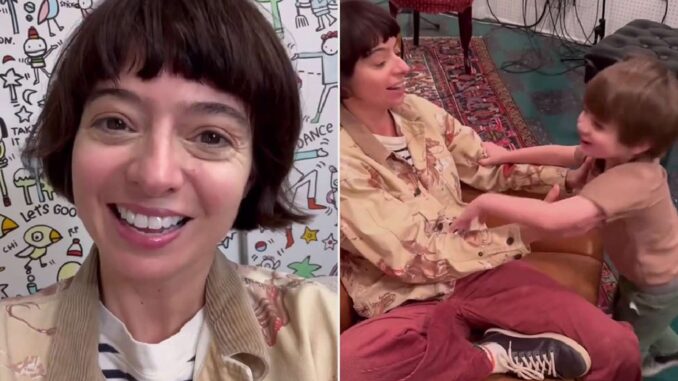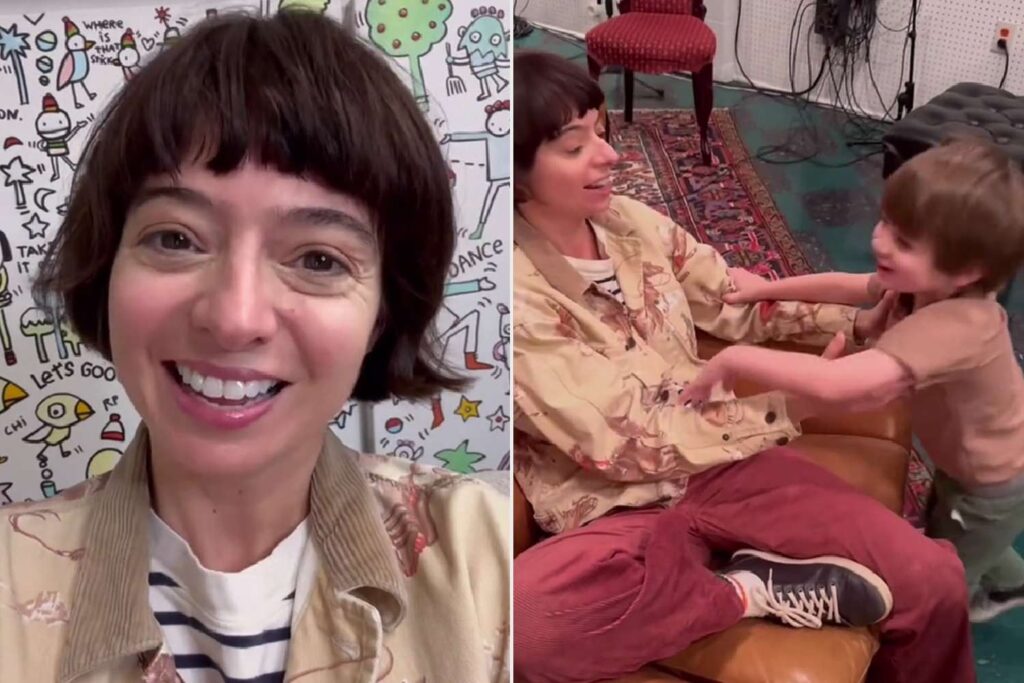
Nearly one year has passed since “Big Bang Theory” star Kate Micucci, 44, underwent lung cancer surgery after being diagnosed with an early stage of the disease. Now, the beloved actress and comedian has immersed herself in an art challenge raising money for GO2 Foundation for Lung Cancer.
Micucci, known for her memorable role as Raj’s love interest Lucy on the TV sitcom “Big Bang Theory,” thankfully caught her lung cancer in its early stages and treated it quickly. The diagnosis was certainly a shock as the actress never smoked. Although cigarette smoking is the top risk factor for the disease, nonsmokers can and do get lung cancer.
Since her Micucci’s successful surgery, she’s been focusing on creating art and getting stronger in the gym—something she often takes to social media to share. And her most recent accomplishment was completing a 30-day art challenge.
Micucci informed her fans that she was showing off her vibrant, creative artwork at an art show on September 30 in California, with all the proceeds going to the GO2 Foundation for Lung Cancer.
Before hitting day 30, she shared an uplifting video on Instagram showing all the fun she had leading up the the conclusion of her art journey, writing, “I did it! Day 29 of my 30 day art challenge. I made a cheesy montage of my month of making art – set to one of my favorite songs ever. Special appearance by the great @melissavcomedy and her dog Penny.
“There will be an online art sale tomorrow for the smaller pieces. And the larger pieces will be for sale at @strengthacademygym from 7-9 tomorrow. All proceeds go to @go2forlungcancer. Thanks to everyone who followed along this past month!”
She explained in the footage, “When I started this 30 day challenge … little did I know it was going to be the most exciting 30 days of my entire life. Actually, no, it wasn’t that exciting, but it was still really, really fun.
One part of the video shows Micucci dancing with her friends exclaiming “We made art!” on day three of her art journey. Other clips showed her painting cute designs.
Not only is Micucci impressing her fans with her art skills, but she’s also working hard on her physical fitness after cancer, and recently celebrated how she can finally do pushups.
She captioned the post, “Progress at the gym! Thank you to Joz at @strengthacademygym for changing my life.
“Working hard at getting stronger is fun when you do it with the right people. (And sweet dogs too) @strengthacademygym.”
Before doing a number of push ups, Micucci happily tells her viewers, “I’ve never been able to do a push up in my entire life, but now I can. I think.”
Micucci also shared a video of herself skateboarding with her four-year-old son back in April, further showing how great she’s been doing in the months after surgery.

One of her fans commented, “A woman of many talents. What’s next? Kite surfing?,” while another wrote, “Fantastic beauty that needs no commentary. She’s absolutely perfect.”
It’s clear that Micucci, who is married to musician and record producer Jake Sinclair, makes art and health a priority in her life.
In a family photo shared around Christmas time last year, Micucci admitted to “feeling extra grateful this year,” as she shared a photo of her family and their dog in a room filled with art.
Kate’s Cancer Journey
In December 2023, Micucci revealed on TikTok that she had been diagnosed with lung cancer despite having never smoked – a leading risk factor for lung cancer.
“I’ve never smoked a cigarette in my life, so it was a surprise,” Micucci said in the video clip.
She says she’s grateful her cancer was caught in its early stages, which is rare considering lung cancer’s subtle symptoms make it difficult to detect during its early stages when it is easier to treat.
She underwent surgery for treatment the same month she revealed her diagnosis. Research published in the open-access journal Cancer Medicine notes patients who undergo lung cancer surgery “often suffer pain after discharge.”
“Managing pain after surgery is difficult once you get home,” thoracic surgery nurse Melissa Jane Culligan tells SurvivorNet.
While recovering from surgery, patients may have trouble sleeping.
“It’s important that you stay connected and, as things change that maybe don’t feel right, that you connect with your care team and make sure that either they do something to make you feel better or that they reassure you that this is to be expected because your pain will change in location and nature,” Culligan said.
Culligan says patients may experience a little more pain after surgery as they become more active. However, that doesn’t mean there’s something wrong. She says it means you may need to take a little bit more pain medicine as your body continues to recuperate.
Cancer Warriors Turning to Art Like Kate Micucci
Kate Micucci has embraced her love for art even more after battling lung cancer, but she isn’t the only cancer warrior who looked to art in dark moments during or after a health battle.
In addition to easing anxiety, creative outlets can also serve as a way for people to share everything they’re feeling in order to cope.
Three-time cancer survivor Marianne Cuozzo also turned to art to express her emotions. Cuozzo was first diagnosed with Hodgkin Lymphoma in 1994 at age 28 and experienced a reoccurrence in 1997.
Then, in 2014, she was diagnosed with breast cancer and underwent a double mastectomy for treatment.
While battling cancer for nearly a decade, Cuozzo told SurvivorNet that she was able to cope during treatment by embracing her creative side and expressing her emotions through her art when she felt overwhelmed.
“I’d go in the studio, and I had these huge pieces of charcoal,” Cuozzo told SurvivorNet in an earlier interview. “And I would do these really angry charcoal drawings, and I’d roll them up and stuff them under the couch. No one was meant to see them because it was just for me and, my cathartic getting out my anger…My artwork is very reflective of my cancer journey.”
You can find Cuozzo’s story, along with others in SurvivorNetTV’s Music and Art: Reflecting On Your Journey, an episode from our original series SN & You that shares cancer survivors’ stories about the importance of music and art during their cancer journey.
Understanding Lung Cancer

Lung cancer forms when cancer cells develop in the tissues of the lung. It is the second most common form of cancer and the leading cause of cancer deaths in both men and women in the U.S., SurvivorNet experts say.
It’s “completely asymptomatic,” says thoracic surgeon-in-chief at Temple University Health System Dr. Joseph Friedberg.
“It causes no issues until it has spread somewhere. So, if it spreads to the bones, it may cause pain. If it spreads to the brain, it may cause something not subtle, like a seizure,” Dr. Friedberg adds.
Scans such as X-rays can help doctors determine if a shadow appears, which can prompt further testing for lung cancer.
There are two main types of lung cancer, which doctors group together based on how they act and how they’re treated:
Non-small cell lung cancer (NSCLC) is the most common type and makes up about 85% of cases. Small cell lung cancer (SCLC) is less common, but it tends to grow faster than NSCLC and is treated very differently.
While lung cancer often doesn’t present symptoms until it has spread, some people may experience signs like:
- A cough that doesn’t go away, that gets worse, or that brings up bloody phlegm
- Shortness of breath
- Fatigue
- Chest pain
- Hoarse voice
- Appetite loss
- Weight loss
If you are experiencing these kinds of symptoms consistently, contact your doctor for further tests.
Treatment options for lung cancer depend on its type, its location, and its staging. In general, treatment methods include surgery, chemotherapy, radiation therapy, targeted therapy, or a combination of any of these treatments.
Smoking and Lung Cancer Risk
Lung cancer is the leading cause of cancer deaths for men and women in the United States. Nonsmokers still get lung cancer, but cigarette smoking is the number one risk factor for the disease. Tobacco smoke contains a mixture of more than 7,000 different chemicals, at least 70 of which are known to cause cancer, the Centers for Disease Control and Prevention (CDC) says.
The CDC says cigarette smoking is linked to about 80 to 90 percent of lung cancer deaths, and people who smoke cigarettes are 15 to 30 times more likely to get lung cancer or die from lung cancer than people who don’t smoke. Additionally, second-hand smoke can cause lung cancer.
Smoking is, of course, the primary cause of lung cancer, but nonsmokers, like Micucci, can and do develop this disease.
Researchers have made progress in understanding the differences between lung cancer in smokers versus nonsmokers, says Dr. Ronald Natale, a medical oncologist at Cedars-Sinai Medical Center, and they’re developing targeted treatments that will be able to address the genetic drivers of lung cancer in nonsmokers.
“Among patients who are nonsmokers, or former very light smokers, we identify a mutation that we can target with pills in about 60% to 70% of them. That leaves 30% or so, 40%, in whom we either have a target for which we do not have successful treatment,” Dr. Ronald Natale, a medical oncologist at Cedars-Sinai Medical Center, tells SurvivorNet.
“Among patients who are smokers, who have more complex cancers that have hundreds, sometimes thousands of mutations, don’t have a driver mutation that we can give a pill for, which is only a tiny percentage of lifelong smokers. Chemotherapy is the primary treatment in most patients,” Dr. Natale explains further.
